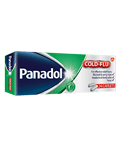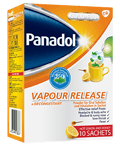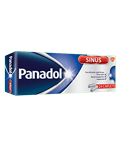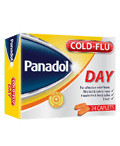- Скачать инструкцию медикамента
Торговое название
Панадол®
Международное непатентованное название
Парацетамол
Лекарственная форма
Таблетки, покрытые пленочной оболочкой 500 мг
Состав
Одна таблетка содержит
активное вещество — парацетамол 500 мг
вспомогательные вещества: крахмал кукурузный, крахмал прежелатинизированный (растворимый), повидон (К 25), калия сорбат, тальк, кислота стеариновая, вода очищенная . Состав пленочной оболочки: гидроксипропилметилцеллюлоза 15 CPS, триацетин.
Описание
Таблетки, покрытые пленочной оболочкой белого цвета, капсуловидной формы, с плоскими краями, маркировкой в виде треугольного логотипа на одной стороне и риской – на другой.
Фармакотерапевтическая группа
Анальгетики. Анальгетики-антипиретики другие. Анилиды. Парацетамол
Код АТХ N02BE01
Фармакологические свойства
Фармакокинетика
Парацетамол быстро и практически полностью всасывается из желудочно-кишечного тракта. Максимальная концентрация в плазме крови достигается через 30-60 минут. Период полувыведения составляет 1-4 часа при приеме в терапевтических дозах. Равномерно распределяется во всех жидкостях организма. Связывание с белками плазмы вариабельно, от 20 до 30% препарата связывается в случае острой интоксикации. При приеме в терапевтических дозах 90-100% препарата выводится с мочой в течение первого дня. Основное количество парацетамол выводится после конъюгации в печени, 5% — в неизменном виде.
Фармакодинамика
Парацетамол – анальгетик-антипиретик. Оказывает обезболивающий и жаропонижающий эффект путем подавления синтеза простагландинов в гипоталамусе. Отсутствие блокирующего влияния на синтез простагландинов в периферических тканях обуславливает отсутствие у него отрицательного влияния на слизистую оболочку желудочно-кишечного тракта. В связи с этим применение парацетамола особенно целесообразно у пациентов, для которых подавление синтеза простагландинов в периферических тканях нежелательно, например при наличии в анамнезе желудочно-кишечных кровотечений или у пожилых пациентов.
Показания к применению
— головная боль, мигрень, зубная боль, боль после удаления зуба или других стоматологических вмешательств, боль в суставах и мышцах, лихорадка и боль после вакцинации, боль в горле, болезненные менструации, боль при остеоартрите, снижение повышенной температуры.
Способ применения и дозы
Взрослые (включая пожилых) и дети 12 лет и старше: 500-1000 мг (1-2 таблетки) каждые 4-6 часов по необходимости. Интервал между приёмами – не менее 4 часов. Максимальная суточная доза – 4000 мг (8 таблеток).
Дети (6-11 лет): 250-500 мг (½ — 1 таблетка) каждые 4-6 часов при необходимости. Интервал между приёмами – не менее 4 часов. Максимальная суточная доза составляет 60 мг/кг массы тела ребенка, разделенная на разовые дозы в 10-15 мг/кг в течение 24 часов. Разовую дозу можно принимать не более 4 раз в течение 24 часов. Максимальная длительность применения без назначения и наблюдения врача – 3 дня.
Если симптомы сохраняются, следует обратиться к врачу.
Не превышайте указанную дозу.
Не принимать одновременно с другими парацетамол-содержащими препаратами.
Побочное действие
Очень редко (<1/10 000)
— анафилаксия, реакции гиперчувствительности, включая кожную сыпь, ангионевротический отек, синдром Стивенса-Джонсона
— тромбоцитопения
— бронхоспазм у пациентов с повышенной чувствительностью к ацетилсалициловой кислоте и другим НПВП (Не следует принимать препарат, если ранее наблюдались нарушения дыхания при приеме ацетилсалициловой кислоты или нестероидных противовоспалительных препаратов)
— нарушение функции печени
Следует немедленно прекратить прием препарат и обратиться к врачу при возникновении вышеперечисленных побочных реакций, а также при появлении шелушения на коже, образования язвочек в полости рта, затруднения дыхания, отека губ, языка, горла и лица, гематом, кровотечения или любой другой нежелательной реакции на препарат.
Противопоказания
— повышенная чувствительность к парацетамолу или любому другому
ингредиенту препарата
— детский возраст до 6 лет
Лекарственные взаимодействия
Препарат при приёме в течение длительного времени усиливает эффект непрямых антикоагулянтов (варфарин и другие кумарины), что увеличивает риск кровотечений; разовые дозы не оказывают существенного влияния.
Особые указания
Не рекомендуется принимать одновременно с другими парацетамол-содержащими препаратами.
Перед приемом препарата необходимо проконсультироваться с врачом:
— пациентам с хроническими заболеваниями печени (сопутствующие заболевания печени увеличивают риск повреждения печени при приеме парацетамола)
— пациентам с хроническими заболеваниями почек
— пациентам, принимающим варфарин или другие препараты для разжижения крови
— в случае если головная боль становится постоянной
— пациентам при наличии состояний, которые сопровождаются снижением уровня глутатиона (например, с тяжелыми инфекциями, такими как сепсис), что может увеличить риск возникновения метаболического ацидоза.
Симптомами метаболического ацидоза являются глубокое, учащенное или затрудненное дыхание, тошнота, рвота, потеря аппетита.
Следует незамедлительно обратиться к врачу в случае появления этих симптомов.
Риск передозировки более вероятен у пациентов с нецирротическим алкогольным заболеванием печени.
Беременность и период лактации
Эпидемиологические данные по применению парацетамола во время беременности демонстрируют отсутствие отрицательного воздействия при приеме в рекомендуемых дозах, однако перед приемом препарата необходимо проконсультироваться с врачом. Парацетамол проходит через плацентарный барьер и попадает в грудное молоко, но в клинически незначительных количествах. Доступные опубликованные данные не содержат противопоказаний относительно приема препарата в период кормления грудью.
Особенности влияния лекарственного средства на способность управлять транспортным средством или потенциально опасными механизмами
Ограничений по вождению автомобиля и работе с механизмами нет.
Передозировка
В случае превышения рекомендованной дозы следует немедленно обратиться за медицинской помощью, даже при хорошем самочувствии, так как существует риск отсроченного серьезного повреждения печени.
Поражение печени у взрослых возможно при приеме 10 и более граммов парацетамола. Прием 5 и более граммов парацетамола может привести к поражению печени у пациентов, имеющих следующие факторы риска:
— продолжительное лечение карбамазепином, фенобарбиталом, фенитоином, примидоном, рифампицином, препаратами зверобоя продырявленного, или другими препаратами, стимулирующими ферменты печени;
— регулярное злоупотребление алкоголем;
— состояния, сопровождающиеся снижением уровня глутатиона (нарушения питания, муковисцидоз, ВИЧ-инфекция, голодание, истощение).
Симптомами острого отравления парацетамолом в первые 24 часа являются тошнота, рвота, боли в желудке, потливость, бледность кожных покровов. Поражение печени определяется через 12-48 часов после передозировки.
Могут возникать нарушения метаболизма глюкозы и метаболический ацидоз. При тяжелом отравлении печеночная недостаточность может прогрессировать в энцефалопатию, кровоизлияния, гипогликемию, отек мозга и летальный исход. Острая почечная недостаточность с острым некрозом канальцев может проявляться сильной поясничной болью, гематурией, протеинурией и развиться даже при отсутствии тяжелого поражения печени. Отмечались также сердечная аритмия и панкреатит.
Лечение: При передозировке необходима незамедлительная медицинская помощь. Пациента следует немедленно доставить в больницу, даже если отсутствуют ранние симптомы передозировки. Симптомы могут ограничиваться тошнотой и рвотой или могут не отражать тяжести передозировки или риска поражения органов. Лечение активированным углем целесообразно в случае, когда чрезмерная доза парацетамола была принята в течение 1 часа. Концентрацию парацетамола в плазме крови следует определять не ранее чем через 4 часа и даже позже после приема препарата (более раннее определение концентрации не является достоверным).
Лечение N-ацетилцистеином можно проводить в течение 24 часов после приема парацетамола, однако, максимальный эффект от данного антидота возможно получить при его применении в течение 8 часов после приема. Эффективность антидота резко снижается после этого времени. При необходимости N-ацетилцистеин вводят пациенту внутривенно согласно рекомендуемым дозам. При отсутствии рвоты возможно применение метионина перорально как альтернатива при невозможности экстренной транспортировки пациента в больницу.
Форма выпуска и упаковка
По 6, 8 или 12 таблеток помещают в контурную ячейковую упаковку из пленки поливинилхлоридной и фольги алюминиевой.
1 (по 6 или 12 таблеток) или 8 (по 8 таблеток) контурных ячейковых упаковок вместе с инструкцией по применению помещают в картонную коробку.
Условия хранения
Хранить при температуре не выше 25ºC
Хранить в недоступном для детей месте!
Срок хранения
5 лет
Не употреблять после истечения срока годности.
Условия отпуска из аптек
Без рецепта
Наименование и страна организации-производителя
«ГлаксоСмитКляйн Дангарван Лтд», Ирландия
Knockbrack, Dungarvan, County Waterford, Republic of Ireland
Наименование и страна владельца регистрационного удостоверения
«ГлаксоСмитКляйн Консьюмер Хелскер», Великобритания
Наименование и страна организации-упаковщика
Эс.Си. Еврофарм С.А., Румыния
2 Panselelor str, Brasov, county of Brasov, 500419, Romania
Адрес организации, принимающей на территории Республики Казахстан претензии от потребителей по качеству продукции (товара)
ПК «ГлаксоСмитКляйн Экспорт Лтд»
г.Алматы, ул. Фурманова, 273. тел. +7 (727) 258-28-92, (727) 244-69-99, факс +7 (727) 258-28-90 (автомат). Электронная почта: kz.safety@gsk.com
250 mg Paracetamol + 100mg Guaifenesin + 5mg Phenylephrine Hydrochloride
Panadol Cold + Flu All in one tablet provide relives from cold + flu symptoms including chesty cough.
- Read more
- Read less
| Age | Dose | How Often |
|---|---|---|
|
Adults + children aged 12 years and older |
1-2 tablets |
|
-
Panadol Cold + Flu
-
Panadol Cold + Flu Vapour Release + Decongestant
-
Panadol Sinus
- «
- 1
- 2
- 3
- »
Usage directions, ingredients and warnings
Before using Panadol Cold + Flu All in One be sure to check the product ingredients and directions for use, and make sure you are familiar with any warnings and precautions.
Learn more below.
Place tablet(s) in mouth and swallow with water.
Each caplet contains:
- Paracetamol = 250mg
- Guaifenesin = 100 mg
- Phenylephrine Hydrochloride =5 mg
Disclaimer
- Do not use if you have known or previous history of hypersensitivity to paracetamol, guaifenesin, phenylephrine, or any other ingredient in this product
- Do not use if you are taking, or have taken, within the last two weeks, monoamine oxidase inhibitors
- Do not be used with other paracetamol-containing products, decongestants, or cough and cold medicines.
Seek medical advice before taking this product if:
- You have Hypertension, Cardiovascular Disease, Diabetes, Hyperthyroidism, Angle closure glaucoma,Phaeochromocytoma, An enlargement of the prostate gland,Occlusive vascular disease (e.g. Raynaud’s Phenomenon),Liver and kidney impairment, glutathione depleted states such as sepsis
- You are taking beta-blockers and other antihypertensive drugs or tricyclic antidepressants
- This product should not be used by patients taking other sympathomimetics (such as decongestants, appetite suppressants).
- If symptoms persist, medical advice must be sought.
- Keep out of sight and reach of children
- Do not give to children under 12 years of age
Enquiries
If you would like any further information regarding Panadol products, please call our INFOLINE (Freecall) +973 16500404 — Gulf & Near East countries
Related Articles
Related Products
-
Panadol Cold + Flu Vapour Release
(+ Decongestant) -
Panadol Cold + Flu
Day -
Panadol Sinus
- «
- 1
- 2
- 3
- »
-
0 ₽ 0 товаров
Каталог инструкций по эксплуатации на русском языке
В нашем каталоге более 90.000 инструкций по эксплуатации и руководств пользователя на русском языке к бытовой технике и электронике. Чтобы скачать инструкцию по эксплуатации выберите интересую вас категорию или воспользуйтесь поиском в верхнем правом углу сайта.
Поиск Yandex
Поиск Google
Поиск OnlineManuals
В данном разделе сайта собраны инструкции по эксплуатации, руководства пользователя для бытовой техники и электроники. Вы можете легко найти и скачать инструкции на русском языке по эксплуатации техники ведущих мировых производителей или изучить их в режиме онлайн, а также отправить необходимое руководство пользователя на e—mail прямо с сайта. Для Вашего удобства, все инструкции и руководства по эксплуатации разделены по типу техники и по производителю. Вы можете искать инструкцию по бренду, самые известные из них: Apple, Ariston, Ardo, Bosch, Nikon, LG, Samsung, Beko, Indesit, Canon, Siemens, HP, Panasonic, Zanussi. Бесплатные инструкции на русском понадобятся Вам в случаях, если Вы потеряли или случайно выбросили свои. Вам обязательно необходимо руководство по эксплуатации на русском языке для вашей бытовой техники и электроники, чтобы использовать свою технику правильно. Бесплатные инструкции и руководства пользователя на русском и английском языках можно легко посмотреть и скачать на нашем специализированном ресурсе OnlineManuals.ru.
Top 20 medicines with the same components:
OmnimedBeechams All-in-OneLemsip (guaifenesin_Paracetamol_Phenylephrine hydrochloride)Vicks Flu Tripla AzioneLemsip Max All in OneNirolex Flu Tripla AzioneTherafluВикс АнтиГрипп КОМПЛЕКСBeechams Max Strength All in OnePanadol Cold&Flu all in onePanadol Cough & ColdVicks Flu Tripla Azione (Acetaminophen,Guaifenesin,Phenylephrine Hydrochloride)Benylin Phlegm Cough & Cold Multi-ReliefPanadol Cold & Cough (Acetaminophen,Guaifenesin,Phenylephrine Hydrochloride)Panadol Cold&Flu all in one (Acetaminophen,Guaifenesin,Phenylephrine Hydrochloride)Benylin Chesty Cough & ColdTriactimedVicks DayQuil Complete (Acetaminophen,Guaifenesin,Phenylephrine Hydrochloride)Boots Mucus Cough & Cold Relief All in OneNirolex Flu Tripla Azione (Acetaminophen,Guaifenesin,Phenylephrine Hydrochloride)
Top 20 medicines with the same treatments:
The information provided in of Panadol Cold&Flu all in one
is based on data of another medicine with exactly the same composition as the Panadol Cold&Flu all in one.
. Be careful and be sure to specify the information on the section in the instructions to the drug Panadol Cold&Flu all in one directly from the package or from the pharmacist at the pharmacy.
more…
Panadol Cold&Flu all in one
Qualitative and quantitative composition
The information provided in Qualitative and quantitative composition of Panadol Cold&Flu all in one
is based on data of another medicine with exactly the same composition as the Panadol Cold&Flu all in one.
. Be careful and be sure to specify the information on the section Qualitative and quantitative composition in the instructions to the drug Panadol Cold&Flu all in one directly from the package or from the pharmacist at the pharmacy.
more…
Guaifenesin; Phenylephrine Hydrochloride; Acetaminophen
Therapeutic indications
The information provided in Therapeutic indications of Panadol Cold&Flu all in one
is based on data of another medicine with exactly the same composition as the Panadol Cold&Flu all in one.
. Be careful and be sure to specify the information on the section Therapeutic indications in the instructions to the drug Panadol Cold&Flu all in one directly from the package or from the pharmacist at the pharmacy.
more…
For the relief of symptoms of colds and influenza, including the relief of aches and pains, sore throat, headache, nasal congestion, lowering of temperature and chesty coughs.
Dosage (Posology) and method of administration
The information provided in Dosage (Posology) and method of administration of Panadol Cold&Flu all in one
is based on data of another medicine with exactly the same composition as the Panadol Cold&Flu all in one.
. Be careful and be sure to specify the information on the section Dosage (Posology) and method of administration in the instructions to the drug Panadol Cold&Flu all in one directly from the package or from the pharmacist at the pharmacy.
more…
Patients should consult a doctor or pharmacist if symptoms persist for more than 3 days, or worsen.
Posology:
Adults and adolescents 12 years and over: One sachet dissolved by stirring in hot water and sweetened to taste.
Dose may be repeated in 4-6 hours. No more than four doses should be taken in 24 hours.
Not to be given to children under 12.
Method of administration
Oral administration after dissolution in water.
Elderly Population: No dosage adjustment is considered necessary in the elderly.
Contraindications
The information provided in Contraindications of Panadol Cold&Flu all in one
is based on data of another medicine with exactly the same composition as the Panadol Cold&Flu all in one.
. Be careful and be sure to specify the information on the section Contraindications in the instructions to the drug Panadol Cold&Flu all in one directly from the package or from the pharmacist at the pharmacy.
more…
—
— Severe coronary heart disease and cardiovascular disorders
— Hypertension
— Hyperthyroidism
— Contraindicated in patients currently receiving or within two weeks of stopping therapy with monoamine oxidase inhibitors (MAOI)
— Concomitant use of other sympathomimetic decongestants
Special warnings and precautions for use
The information provided in Special warnings and precautions for use of Panadol Cold&Flu all in one
is based on data of another medicine with exactly the same composition as the Panadol Cold&Flu all in one.
. Be careful and be sure to specify the information on the section Special warnings and precautions for use in the instructions to the drug Panadol Cold&Flu all in one directly from the package or from the pharmacist at the pharmacy.
more…
Use with caution in patients with Raynaud’s phenomenon or diabetes mellitus.
Care is advised in the administration of paracetamol to patients with severe renal or severe hepatic impairment. The hazard of overdose is greater in those with non-cirrhotic alcoholic liver disease.
Patients should be advised not to take other paracetamol -containing products concurrently.
Immediate medical advice should be sought in the event of an overdose, even if the patient feels well because of the risk of delayed serious liver damage.
Phenylephrine should be used with care in patients with closed angle glaucoma and prostatic enlargement.
The product should not be used during pregnancy unless recommended by a healthcare professional.
Use during breastfeeding should be avoided, unless recommended by a healthcare professional.
Patients with rare hereditary problems of galactose intolerance, the Lapp lactase deficiency or glucose-galactose malabsorption should not take this medicine.
Patients with rare hereditary problems of fructose intolerance, glucose- galactose malabsorption or sucrase-isomaltase insufficiency should not take this medicine.
This product also contains 1973.3mg sucrose per dose (total sugars 2g). Patients with rare hereditary problems of fructose intolerance, glucose-galactose malabsorption or sucrase-isomaltase insufficiency should not take this medicine.
This product contains 129.0mg (5.6mmol) sodium per dose — to be taken into consideration for patients on a controlled sodium diet.
Contains a source of phenylalanine. May be harmful for people with phenylketonuria.
Effects on ability to drive and use machines
The information provided in Effects on ability to drive and use machines of Panadol Cold&Flu all in one
is based on data of another medicine with exactly the same composition as the Panadol Cold&Flu all in one.
. Be careful and be sure to specify the information on the section Effects on ability to drive and use machines in the instructions to the drug Panadol Cold&Flu all in one directly from the package or from the pharmacist at the pharmacy.
more…
Panadol Cold&Flu all in one Lemon has no or negligible influence on ability to drive or use machinery.
Undesirable effects
The information provided in Undesirable effects of Panadol Cold&Flu all in one
is based on data of another medicine with exactly the same composition as the Panadol Cold&Flu all in one.
. Be careful and be sure to specify the information on the section Undesirable effects in the instructions to the drug Panadol Cold&Flu all in one directly from the package or from the pharmacist at the pharmacy.
more…
Adverse events which have been associated with paracetamol, guaifenesin and phenylephrine are given below, tabulated by system organ class and frequency. Frequencies are defined as: Very common (>1/10); Common (>1/100 and <1/10); Uncommon (>1/1000 and <1/100); Rare (>1/10,000 and <1/1000); Very rare (< 1/10,000); Not known (cannot be estimated from the available data). Within each frequency grouping, adverse events are presented in order of decreasing seriousness.
|
System Organ Class |
Frequency |
Adverse Events |
|
Blood and Lymphatic System Disorders |
Not known |
Thrombocytopenia, leucopenia, pancytopenia, neutropenia, agranulocytosis1 |
|
Immune System Disorders |
Not known |
Hypersensitivity |
|
Gastrointestinal Disorders |
Not known |
Abdominal discomfort, nausea, vomiting |
|
Skin and Subcutaneous Tissue Disorders |
Very rare Not known |
Cases of serious skin reactions have been reported Skin rash |
|
Renal and Urinary Disorders |
Not known |
Urinary retention2 |
Description of Selected Adverse Reactions
1 There have been reports of blood dyscrasias including thrombocytopenia, leucopenia, pancytopenia, neutropenia and agranulocytosis, but these were not necessarily causally related to paracetamol.
2 Especially in males
Reporting of Suspected Adverse Reactions
Reporting suspected adverse reactions after authorisation of the medicinal product is important. It allows continued monitoring of the benefit/risk balance of the medicinal product. Healthcare professionals are asked to report any suspected adverse reactions via the Yellow Card Scheme at: www.mhra.gov.uk/yellowcard.
Overdose
The information provided in Overdose of Panadol Cold&Flu all in one
is based on data of another medicine with exactly the same composition as the Panadol Cold&Flu all in one.
. Be careful and be sure to specify the information on the section Overdose in the instructions to the drug Panadol Cold&Flu all in one directly from the package or from the pharmacist at the pharmacy.
more…
Paracetamol
Liver damage is possible in adults who have taken 10 g or more of paracetamol. Ingestion of 5 g or more of paracetamol may lead to liver damage if the patient has risk factors (see below).
Risk Factors
If the patient:
(a) Is on long-term treatment with carbamazepine, phenobarbitone, phenytoin, primidone, rifampicin, St John’s Wort or other drugs that induce liver enzymes,
or
(b) Regularly consumes ethanol in excess of recommended amounts,
or
(c) Is likely to be glutathione depleted, e.g. eating disorders, cystic fibrosis, HIV infection, starvation, cachexia.
Symptoms
Symptoms of paracetamol overdose in the first 24 hours are pallor, nausea, vomiting, anorexia and abdominal pain. Liver damage may become apparent 12 to 48 hours after ingestion. Abnormalities of glucose metabolism and metabolic acidosis may occur. In severe poisoning, hepatic failure may progress to encephalopathy, haemorrhage, hypoglycaemia, cerebral oedema, and death. Acute renal failure with acute tubular necrosis, strongly suggested by loin pain, haematuria and proteinuria, may develop even in the absence of severe liver damage. Cardiac arrhythmias and pancreatitis have been reported.
Management
Immediate treatment is essential in the management of paracetamol overdose. Despite a lack of significant early symptoms, patients should be referred to hospital urgently for immediate medical attention. Symptoms may be limited to nausea or vomiting and may not reflect the severity of overdose or the risk of organ damage. Management should be in accordance with established treatment guidelines, see BNF overdose section.
Treatment with activated charcoal should be considered if the overdose has been taken within 1 hour. Plasma paracetamol concentration should be measured at 4 hours or later after ingestion (earlier concentrations are unreliable). Treatment with N-acetylcysteine may be used up to 24 hours after ingestion of paracetamol, however, the maximum protective effect is obtained up to 8 hours post-ingestion. The effectiveness of the antidote declines sharply after this time. If required the patient should be given intravenous N-acetylcysteine, in line with the established dosage schedule. If vomiting is not a problem, oral methionine may be a suitable alternative for remote areas, outside hospital. Management of patients who present with serious hepatic dysfunction beyond 24 hours from ingestion should be discussed with the NPIS or a liver unit.
Phenylephrine hydrochloride
Features of severe overdose of phenylephrine include haemodynamic changes and cardiovascular collapse with respiratory depression. Treatment includes symptomatic and supportive measures. Hypertensive effects may be treated with an i.v. alpha-receptor-blocking agent.
Phenylephrine overdose is likely to result in: nervousness, headache, dizziness, insomnia, increased blood pressure, nausea, vomiting, mydriasis, acute angle closure glaucoma (most likely to occur in those with closed angle glaucoma), tachycardia, palpitations, allergic reactions (e.g. rash, urticaria, allergic dermatitis), dysuria, urinary retention (most likely to occur in those with bladder outlet obstruction, such as prostatic hypertrophy).
Additional symptoms may include, hypertension, and possibly reflex bradycardia. In severe cases confusion, seizures and arrhythmias may occur. However the amount required to produce serious phenylephrine toxicity would be greater than that required to cause paracetamol-related liver toxicity.
Treatment should be as clinically appropriate. Severe hypertension may need to be treated with alpha blocking medicinal products such as phentolamine.
Guaifenesin
Very large doses may cause nausea and vomiting. The active substance is, however, rapidly metabolised and excreted in the urine. Patients should be kept under observation and treated symptomatically.
Pharmacodynamic properties
The information provided in Pharmacodynamic properties of Panadol Cold&Flu all in one
is based on data of another medicine with exactly the same composition as the Panadol Cold&Flu all in one.
. Be careful and be sure to specify the information on the section Pharmacodynamic properties in the instructions to the drug Panadol Cold&Flu all in one directly from the package or from the pharmacist at the pharmacy.
more…
Pharmacotherapeutic group: Analgesics, Anilides,
ATC Code: N02B E51. Paracetamol, combinations excl. psycholeptics
Paracetamol: Paracetamol has both analgesic and antipyretic activity, which is believed to be mediated principally through its inhibition of prostaglandin synthesis within the central nervous system.
Phenylephrine hydrochloride: Phenylephrine is sympathomimetic post-synaptic α1-adrenergic receptor agonist with low cardioselective beta receptor affinity and minimal central nervous stimulant activity. It is a recognised decongestant and acts by vasoconstriction to reduce oedema and nasal swelling.
Guaifenesin: Guaifenesin is an expectorant which reduces the viscosity of tenacious sputum.
The active ingredients are not known to cause sedation.
Pharmacokinetic properties
The information provided in Pharmacokinetic properties of Panadol Cold&Flu all in one
is based on data of another medicine with exactly the same composition as the Panadol Cold&Flu all in one.
. Be careful and be sure to specify the information on the section Pharmacokinetic properties in the instructions to the drug Panadol Cold&Flu all in one directly from the package or from the pharmacist at the pharmacy.
more…
Paracetamol: Paracetamol is absorbed rapidly and completely from the small intestine, producing peak plasma levels after 15-20 minutes following oral dosing. The systemic availability is subject to first-pass metabolism and varies with dose between 70% and 90%. The drug is rapidly and widely distributed throughout the body and is eliminated from plasma with a T½ of approximately 2 hours. The major metabolites are glucuronide and sulphate conjugates (>80%) which are excreted in urine.
Phenylephrine hydrochloride: Phenylephrine is absorbed from the gastrointestinal tract, but has reduced bioavailability by the oral route due to first-pass metabolism. It retains activity as a nasal decongestant when given orally, the drug distributing through the systemic circulation to the vascular bed of the nasal mucosa. When taken by mouth as a nasal decongestant phenylephrine is usually given at intervals of 4-6 hours.
Guaifenesin: Guaifenesin is absorbed from the gastrointestinal tract. It is rapidly metabolised by oxidation to ί-(2 methoxy-phenoxy) lactic acid; which is excreted in the urine. Within 3 hours, approximately 40% of a single dose is excreted in the urine as this metabolite. The half-life in plasma is approximately 1 hour. Guaifenesin may increase the rate of absorption of paracetamol.
Pharmacotherapeutic group
The information provided in Pharmacotherapeutic group of Panadol Cold&Flu all in one
is based on data of another medicine with exactly the same composition as the Panadol Cold&Flu all in one.
. Be careful and be sure to specify the information on the section Pharmacotherapeutic group in the instructions to the drug Panadol Cold&Flu all in one directly from the package or from the pharmacist at the pharmacy.
more…
Analgesics, Anilides,
Preclinical safety data
The information provided in Preclinical safety data of Panadol Cold&Flu all in one
is based on data of another medicine with exactly the same composition as the Panadol Cold&Flu all in one.
. Be careful and be sure to specify the information on the section Preclinical safety data in the instructions to the drug Panadol Cold&Flu all in one directly from the package or from the pharmacist at the pharmacy.
more…
There are no preclinical data of relevance to the prescriber, which are additional to those already included in other sections of the SmPC.
Incompatibilities
The information provided in Incompatibilities of Panadol Cold&Flu all in one
is based on data of another medicine with exactly the same composition as the Panadol Cold&Flu all in one.
. Be careful and be sure to specify the information on the section Incompatibilities in the instructions to the drug Panadol Cold&Flu all in one directly from the package or from the pharmacist at the pharmacy.
more…
None known.
Special precautions for disposal and other handling
The information provided in Special precautions for disposal and other handling of Panadol Cold&Flu all in one
is based on data of another medicine with exactly the same composition as the Panadol Cold&Flu all in one.
. Be careful and be sure to specify the information on the section Special precautions for disposal and other handling in the instructions to the drug Panadol Cold&Flu all in one directly from the package or from the pharmacist at the pharmacy.
more…
Not applicable.
References:
- https://www.drugs.com/search.php?searchterm=panadol-cold-flu-all-in-one
- https://pubmed.ncbi.nlm.nih.gov/?term=panadol-cold-flu-all-in-one








